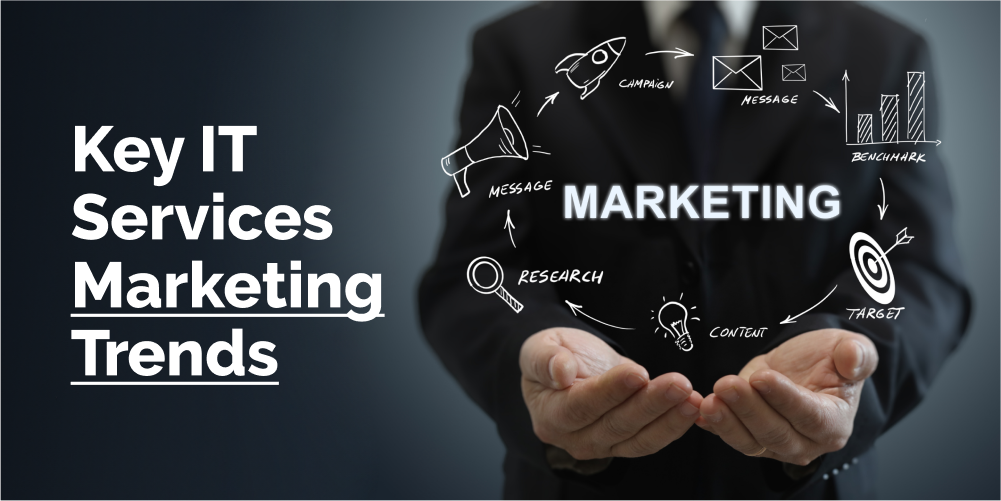Marketing Technology, zBlog
Top Marketing Trends for IT Services in 2025
Team Trantor | Updated: April 4, 2024
Introduction
In the ever-evolving Marketing Trends for IT Services, companies must be agile and innovative to stay ahead of the curve. As technologies advance rapidly, so too must the marketing strategies employed to reach and engage modern IT customers. In 2024, we’ll witness a convergence of cutting-edge technologies, shifting consumer behaviors, and a heightened emphasis on personalization, authenticity, and value-driven experiences.
AI-Powered Personalization: Tailoring the Message to the Individual

- The Need for Personalized Experiences
In today’s crowded marketplace, a one-size-fits-all approach to marketing is no longer sufficient. Modern IT customers expect a highly personalized customer experience that speaks directly to their unique needs, preferences, and pain points. They demand tailored solutions that demonstrate a deep understanding of their specific challenges and requirements. - Leveraging AI for Data-Driven Insights
Enter AI-powered marketing automation platforms, which can analyze vast troves of customer data to gain deep insights into their behaviors, past interactions, and industry-specific requirements. By leveraging machine learning algorithms and advanced analytics, these platforms can uncover patterns and preferences that would be nearly impossible to discern through manual analysis alone. - Striking a Balance: Human Touch and AI Automation
While AI offers powerful personalization capabilities, it’s crucial to strike a balance between leveraging these tools and maintaining a human touch. AI can provide valuable insights and automate certain aspects of the personalization process, but human creativity and storytelling remain essential for crafting compelling narratives and building lasting connections with clients. A harmonious blend of AI-driven insights and human ingenuity is key to delivering truly personalized and resonant experiences.
Short-Form Video Content: Capturing Attention in a Fleeting Moment

- The Rise of Bite-Sized Content
In a world where attention spans are shrinking and consumers are constantly bombarded with information, short-form video content has emerged as a powerful tool for capturing and retaining audience interest. Platforms like TikTok, Instagram Reels, and YouTube Shorts offer IT services companies the opportunity to showcase their expertise and thought leadership in an easily digestible and engaging format. - Educational and Entertaining Storytelling
These bite-sized videos can educate, entertain, and leave a lasting impression on potential clients, while also serving as a window into the company’s culture and values. For example, an IT security company could create a series of short, engaging videos explaining complex security concepts in an easily understandable way, addressing topics like phishing attacks, multi-factor authentication, or the benefits of cloud-based security solutions. - Connecting with Audiences through Relatable Narratives
However, effective short-form video content is about more than just conveying information – it’s about storytelling. By using humor, relatable scenarios, and real-world examples, IT services companies can connect with their audience on a deeper level and make even the most complex IT concepts accessible and engaging. These videos should aim to educate while also entertaining and fostering an emotional connection with viewers.
Micro-Influencer Marketing: Building Trust with Niche Experts

- The Power of Niche Authority
While mega-influencers may have a massive reach, their audience is often too broad and diverse to effectively target specific niches or industries. Enter micro-influencers – niche experts with engaged followings within specific IT specializations. These individuals have already established trust and authority within their niche, making their recommendations and endorsements highly valuable. - Identifying and Partnering with Micro-Influencers
By partnering with these micro-influencers, IT services companies can tap into a highly targeted and trusted audience, making their marketing efforts more impactful and credible. For instance, an IT services company specializing in cloud-based security solutions could collaborate with IT security specialists who have leveraged social media marketing on platforms like Twitter or LinkedIn. - Fostering Long-Term, Authentic Collaborations
However, it’s crucial to choose micro-influencers whose values and expertise align with the company’s offerings. Focus on building long-term partnerships rather than one-off promotions, and collaboratively engage with these micro-influencers, allowing them to provide creative input for sponsored content or campaigns. This approach not only builds trust and credibility but also fosters a sense of authenticity that resonates with modern IT customers.
User-Generated Video Content (UGC): Empowering Satisfied Customers

- The Voice of the Customer
In the age of social media, the voice of the customer holds immense power. User-generated video content (UGC) allows satisfied clients to become brand advocates, sharing their positive experiences with an IT services company’s solutions and services. This authentic content builds trust and credibility with potential clients, who are more likely to believe real-world experiences from other businesses than traditional marketing messaging. - Encouraging and Incentivizing UGC
To leverage the power of UGC, IT services companies can develop social media campaigns that encourage clients to create and share videos about how their IT solutions have transformed their businesses. This could involve customer testimonials, user stories, or case studies showcasing successful implementations. Offering incentives for participation, such as social media recognition or contest entries, can further incentivize client engagement. - Leveraging UGC Across Marketing Channels
Once a collection of UGC is amassed, companies can utilize it across their marketing channels, featuring customer testimonials on their website, sharing client stories on social media, and even creating video compilations that showcase the positive impact of their services. By giving a platform to satisfied customers, IT services companies can build trust and credibility with potential clients in an authentic and compelling way.
Values-Driven Content: Aligning with Your Customer’s Priorities

- The Importance of Shared Values
Today’s IT customers are increasingly concerned with the values a company embodies, and they expect the brands they engage with to align with their own priorities. By developing content that reflects a commitment to sustainability, diversity, and social responsibility, IT services companies can demonstrate that they are aligned with the values that matter most to their target audience. - Demonstrating Commitment through Actions
However, simply stating values is not enough – companies must back their claims with concrete actions and initiatives. Highlighting awards or certifications that demonstrate a commitment to sustainability or social responsibility, partnering with organizations that align with their values for events or sponsorships, and actively engaging in community outreach efforts can all help to reinforce the company’s values-driven approach. - Building Trust and Deeper Connections
This type of values-driven content fosters trust and creates a deeper connection with potential clients, positioning the company as a values-driven partner rather than just a service provider. By aligning themselves with the priorities that matter most to their audience, IT services companies can differentiate themselves from competitors and establish lasting, meaningful relationships with their clients.
The Power of Community Building: Fostering Connections and Knowledge Sharing

- The Value of Online Communities
In an increasingly digital world, fostering a sense of community is crucial for building lasting connections with customers and positioning a company as a thought leader in its industry. Online communities provide a platform for IT professionals to connect, share knowledge, and engage with a brand in a more meaningful way. - Facilitating Engagement and Knowledge Exchange
IT services companies can facilitate this community building by hosting webinars, online forums, or Q&A sessions led by their IT experts. For example, a company could create a dedicated LinkedIn group specifically for IT professionals to discuss cybersecurity best practices and trends. This group could feature discussions, live chats, and Q&A sessions with the company’s security specialists, encouraging members to share their experiences and ask questions, fostering a sense of mutual support and learning. - Benefits Beyond Engagement
Community building offers several advantages beyond engagement. It allows a company to establish itself as a thought leader in the IT industry by providing valuable insights and resources. By serving as a reliable source of information, companies can build trust with potential clients and position themselves as experts in their field. Additionally, these communities can serve as valuable feedback loops, allowing companies to gain insights into the needs and challenges faced by their target audience, informing their product and service offerings.
Data-Driven Decision Making: Turning Insights into Action

- The Age of Data-Driven Marketing
In today’s data-driven world, marketing is no longer a game of chance or gut instinct. IT services companies now have access to a wealth of data that allows them to track campaign performance, measure return on investment (ROI), and optimize their strategies for maximum impact. - Leveraging Analytics for Optimization
By utilizing marketing analytics platforms, companies can gain insights into what content resonates with their audience, which channels deliver the best results, and where their marketing budget can be most effectively allocated. For example, by analyzing website traffic data, a company might discover that blog posts about cloud migration strategies generate high traffic and engagement, prompting them to prioritize creating more content on this topic. - Embracing Continuous Improvement and Experimentation
However, data-driven marketing is an ongoing process of continuous improvement. IT services companies must regularly analyze their campaign performance and make adjustments as needed, embracing a mindset of experimentation and iterative optimization. This approach allows companies to stay agile and responsive, adapting their strategies to shifting market conditions and evolving customer preferences
Importance of SEO: Organic Search Still Reigns Supreme

- The Enduring Relevance of Organic Search
While new marketing channels and tactics continue to emerge, organic search remains a crucial lead generation channel for IT services companies. In an age where consumers increasingly turn to search engines as their primary source of information, having a strong online presence and visibility in search results is paramount. - Creating High-Quality, Optimized Content
By focusing on creating high-quality, informative content optimized for relevant IT industry keywords, companies can ensure their website appears prominently in search engine results pages (SERPs) when potential clients search for solutions to their IT challenges. This could involve publishing blog posts addressing common IT challenges faced by their target audience, utilizing keyword research tools to identify relevant search terms, and optimizing content accordingly. - The Holistic Approach to SEO
However, while keyword optimization is essential, it’s not the only factor search engines consider when ranking websites. IT services companies must adopt a holistic approach to Search Engine Optimization, focusing on creating valuable, comprehensive content that provides solutions to user queries. Ensuring their website offers a good user experience with fast loading times, clear navigation, and mobile-friendliness is also crucial for improving search rankings and driving organic traffic.
The Evolving Landscape of Social Media Marketing: Adapting to New Trends

- Staying Ahead of the Curve
Social media platforms are constantly evolving, introducing new features and functionalities that present both opportunities and challenges for marketers. Staying ahead of the curve is crucial for effective social media marketing in the IT services sector. - Experimenting with New Features and Formats
IT services companies must be willing to experiment with new features like live streams, interactive polls, and augmented reality filters to create engaging content that resonates with their target audience. For example, hosting a live Q&A session on LinkedIn Live with IT experts to answer burning questions about cloud migration could be an effective way to leverage the power of live video and interact directly with potential clients. - Building Relationships, Not Just Reach
However, social media marketing is about more than just broadcasting messages or achieving a large reach. It’s about fostering genuine connections with the audience. IT services companies should prioritize responding to comments and messages promptly, participating in relevant industry discussions, and running contests or giveaways to encourage engagement. Building these relationships and establishing a strong brand presence on social media is key to driving long-term success.
Prioritizing User Experience (UX) on All Platforms: Creating a Seamless Customer Journey

- The Importance of User Experience
In today’s digital landscape, ensuring a seamless and user-friendly experience for potential clients is crucial, regardless of the platform or touchpoint. A well-designed website with clear navigation, relevant content categories, and easy-to-find contact information creates a positive first impression and sets the tone for the entire customer journey. - Optimizing for Mobile
With the increasing use of mobile devices for browsing and information gathering, optimizing for mobile is no longer an option – it’s a necessity. IT services companies must utilize responsive design principles to ensure their website and marketing materials display correctly and provide an optimal and human centered user experience on smartphones and tablets. - Consistency Across Touchpoints
User experience isn’t limited to just the website – it encompasses every interaction a potential client has with the brand, from social media presence to email marketing campaigns. Maintaining consistency in branding, messaging, and overall experience across all touchpoints is essential for creating a cohesive and seamless customer journey.
Conclusion: A Multifaceted Approach to Marketing Success
The IT services industry is a dynamic and competitive space that demands a multifaceted approach to marketing success. By embracing the top trends outlined in this article and tailoring them to their specific niche within the IT sector, companies can effectively engage the modern IT customer.
The key lies in leveraging the power of Artificial Intelligence for personalization, creating captivating short-form video content, and building trust through authentic storytelling and community building. Additionally, prioritizing data-driven decision-making, optimizing for organic search and social media, and ensuring a seamless user experience across all platforms are essential components of a successful marketing strategy.
By implementing these strategies and continuously adapting to emerging trends and technologies, IT services companies can establish themselves as trusted partners and thought leaders in the ever-evolving IT landscape, fostering lasting connections with their clients and driving sustainable growth in an increasingly competitive market.
Trantor a prime example of a company successfully implementing many of these marketing trends for IT services. By leveraging AI-powered personalization, we’ve been able to deliver highly tailored email campaigns and website experiences that resonate with each client’s unique needs.
By prioritizing user experience across all platforms, maintaining a strong SEO presence, and aligning their content with their values of sustainability and diversity, Trantor has solidified its position as a trusted and innovative leader in the IT services space.





